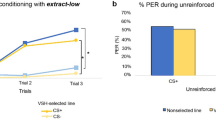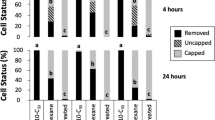Abstract
ETHANOL extracts of the queens of three species of honeybees, Apis mellifera, A. cerana sub-species indica and A. florea, contain substances that inhibit both queen rearing by workers of A. mellifera and development of the ovaries of workers of this species1,2. Rearing of queens and development of workers' ovaries in A. mellifera colonies are inhibited by the pheromone, 9-oxodec-trans-2-enoic acid, which is produced in the queen's mandibular glands3 and which also serves as the olfactory sex attractant in this species4,5. It has been suggested that it would be interesting to find out whether the odours of the queens of the other three species of honeybees, Apis cerana, A. dorsata and A. florea, attract drones of A. mellifera and, if so, whether such attraction is also caused by 9-oxodecenoic acid2. Nubile virgin queens of these species were not available, and so tests were made with mated queens of A. cerana sub-species indica and A. florea which had been preserved in ethanol for several years.
This is a preview of subscription content, access via your institution
Access options
Subscribe to this journal
Receive 51 print issues and online access
$199.00 per year
only $3.90 per issue
Buy this article
- Purchase on Springer Link
- Instant access to full article PDF
Prices may be subject to local taxes which are calculated during checkout
Similar content being viewed by others
References
Butler, C. G., and Gibbons, D., J. Insect Physiol., 2, 61 (1958).
Butler, C. G., Z. Bienenforsch., 8, 143 (1966).
Butler, C. G., Callow, R. K., and Johnston, N. C., Proc. Roy. Soc., B, 155, 417 (1961).
Gary, N. E., Science, 136, 773 (1962).
Butler, C. G., and Fairey, E. M., J. Apic. Res., 3, 65 (1964).
Morrison, W. R., and Smith, L. M., J. Lipid Res., 5, 600 (1964).
Schneider, D., J. Insect Physiol., 8, 15 (1962).
Beroza, M., and Jacobson, M., World Rev. Pest Control, 2, 36 (1963).
Author information
Authors and Affiliations
Rights and permissions
About this article
Cite this article
BUTLER, C., CALAM, D. & CALLOW, R. Attraction of Apis mellifera Drones by the Odours of the Queens of Two Other Species of Honeybees. Nature 213, 423–424 (1967). https://doi.org/10.1038/213423a0
Issue Date:
DOI: https://doi.org/10.1038/213423a0
This article is cited by
-
The neuroethology of olfactory sex communication in the honeybee Apis mellifera L.
Cell and Tissue Research (2021)
-
The genetic consequences of the anthropogenic movement of social bees
Insectes Sociaux (2016)
-
Queen mandibular pheromone: questions that remain to be resolved
Apidologie (2012)
-
Beyond 9-ODA: SEX Pheromone Communication in the European Honey Bee Apis mellifera L.
Journal of Chemical Ecology (2006)
-
Anonymity and specificity in the chemical communication signals of social insects
Journal of Comparative Physiology A (1987)
Comments
By submitting a comment you agree to abide by our Terms and Community Guidelines. If you find something abusive or that does not comply with our terms or guidelines please flag it as inappropriate.



